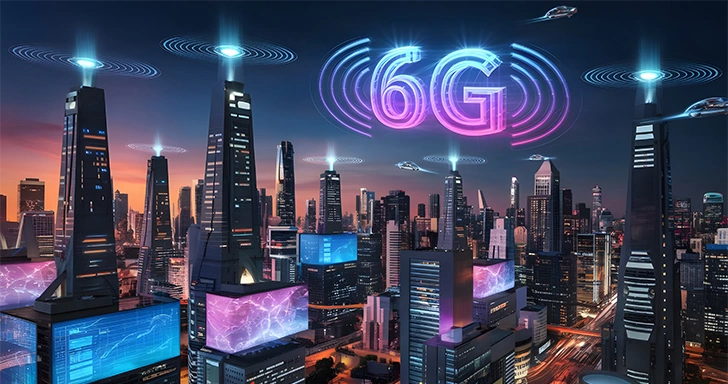The world is witnessing an unprecedented digital transformation, and at the heart of this evolution lies one of humanity’s most powerful innovations — connectivity. As we move from 5G to 6G, the way cities operate, communicate, and serve citizens will be redefined. From intelligent infrastructure to autonomous mobility, the next-generation networks promise to make smart cities smarter, safer, and more sustainable.
The Evolution from 5G to 6G: Beyond Speed and Latency
When 5G rolled out, it was hailed as a game-changer — offering lightning-fast data speeds, ultra-low latency, and massive IoT (Internet of Things) support. However, 6G will take this to an entirely new level.
While 5G focuses on connecting devices efficiently, 6G aims to create a fully integrated digital ecosystem where humans, machines, and AI systems communicate seamlessly. With speeds expected to exceed 1 Tbps (terabits per second) and latency as low as 1 microsecond, 6G will make real-time intelligence a norm rather than a luxury.
Key differences include:
- 5G: High-speed connectivity enabling IoT and automation.
- 6G: Hyper-connectivity enabling AI-driven, autonomous urban systems.
This leap will empower smart cities to process immense data volumes instantly — optimizing everything from transportation and healthcare to energy and governance.
Smart Cities and the Power of Next-Gen Connectivity
Smart cities thrive on data — the more connected and efficient the data flow, the more intelligent the city becomes. With 5G already enabling connected devices and real-time analytics, 6G will elevate these capabilities with integrated AI, quantum communication, and holographic interfaces.

1. Smart Infrastructure
5G has already revolutionized traffic management and urban planning. Cities like Seoul, Singapore, and Dubai use 5G-powered sensors for monitoring air quality, managing traffic, and optimizing utilities.
With 6G, infrastructure will evolve into a self-healing system — capable of detecting maintenance needs, optimizing energy consumption, and responding autonomously to environmental changes.
Example: Imagine a bridge that continuously monitors its own structural integrity and sends real-time alerts to the city’s AI command center if any cracks or stress points are detected.
2. Autonomous Mobility
5G connectivity has made autonomous vehicles (AVs) more viable by ensuring millisecond-level communication between cars and smart traffic lights.
6G, however, will enable coordinated mobility ecosystems, where AVs, drones, and public transport communicate instantly, avoiding congestion and ensuring safety.
For instance, drones powered by 6G networks could deliver emergency supplies or monitor traffic incidents while sharing real-time video feeds with local authorities.
3. Healthcare Without Boundaries
The COVID-19 pandemic underscored the importance of remote healthcare. 5G enabled telemedicine, allowing doctors to consult patients virtually.
6G will take it further — imagine holographic telepresence, where doctors perform remote surgeries through robotic systems guided by real-time, ultra-precise data transmissions.
This will be transformative for rural and underdeveloped regions, bridging healthcare access gaps and saving lives through seamless connectivity.
4. Energy Efficiency and Sustainability
Smart grids powered by 5G have already optimized energy distribution. 6G networks will integrate AI-driven predictive models to analyze consumption patterns, forecast demand, and reduce wastage.
Buildings will become energy-aware — automatically adjusting lighting, cooling, and heating systems based on occupancy and weather. This supports not just sustainability goals but also significant cost savings for citizens and municipalities alike.
5. Real-Time Governance and Public Safety
5G connectivity has already enhanced emergency response systems and surveillance networks.
With 6G, governance will move toward real-time decision-making using AI and edge computing.
For example:
- Predictive policing could anticipate crime hotspots based on historical data and environmental cues.
- Disaster management systems could activate evacuation protocols within seconds during floods, earthquakes, or fires.
Such instant responses could potentially save thousands of lives in emergencies.
Technologies Powering 6G Smart Cities
To understand how 6G will transform cities, it’s essential to know the core technologies that will fuel this evolution:
- Artificial Intelligence (AI): Enables real-time analytics and decision-making.
- Edge Computing: Processes data near the source to minimize latency.
- Quantum Communication: Ensures ultra-secure data transmission.
- Terahertz Waves: Provide ultra-fast data transfer speeds.
- Digital Twins: Create virtual replicas of cities for testing and optimization.
- Holographic Displays: Enable immersive communication for education, design, and healthcare.
Together, these technologies will create hyperconnected, intelligent cities capable of adapting dynamically to citizens’ needs.
Challenges in the Transition from 5G to 6G
While the vision of 6G-powered smart cities is exciting, the journey is not without hurdles.
- Infrastructure Investment: Deploying 6G requires massive infrastructure upgrades, including dense small-cell networks and advanced antennas.
- Data Privacy and Security: With hyper-connectivity comes greater vulnerability. Protecting citizens’ data will be a top priority.
- Regulatory Frameworks: Governments need to establish clear policies for spectrum allocation, interoperability, and ethical AI use.
- Digital Divide: Ensuring equitable access to next-gen connectivity is vital to avoid excluding rural or economically weaker regions.
Overcoming these challenges will demand global collaboration between telecom providers, policymakers, and tech innovators.
The Road Ahead: From 5G to 6G-Driven Smart Cities
Experts predict that 6G will be commercially deployed around 2030, but research and pilot projects are already underway in countries like Japan, South Korea, and the United States.
India too, having become the world’s second-largest 5G smartphone market, is investing in indigenous 6G research to strengthen its digital leadership.
In the coming decade, 6G will not just connect people — it will connect everything: devices, vehicles, sensors, infrastructure, and even digital avatars.
This hyper connected web will lead to:
- Smarter decision-making through predictive analytics.
- Cleaner and greener cities with intelligent energy use.
- Safer streets through automated response systems.
- A more inclusive society with universal connectivity.
Conclusion: The Future Is Hyper connected
The shift from 5G to 6G represents far more than a technological upgrade — it’s a societal transformation.
As 6G networks integrate advanced AI, quantum communication, and immersive digital experiences, cities will evolve into living, breathing ecosystems that think, adapt, and evolve alongside their citizens.
The vision of tomorrow’s smart city isn’t just about faster internet — it’s about creating sustainable, efficient, and human-centric environments powered by next-generation connectivity.
In short, the move from 5G to 6G will define how the world lives, works, and connects — shaping not just smart cities, but a truly intelligent planet.


